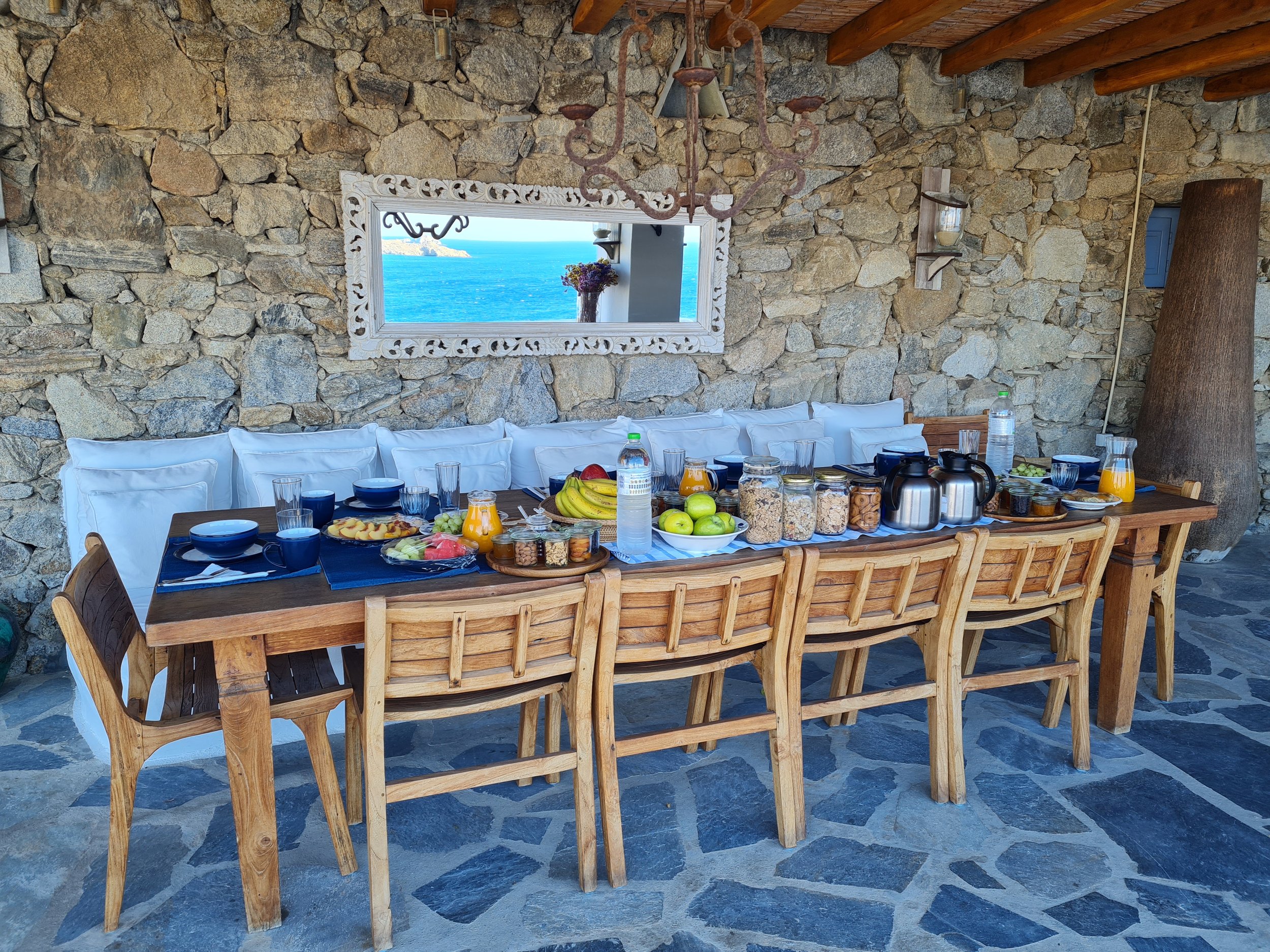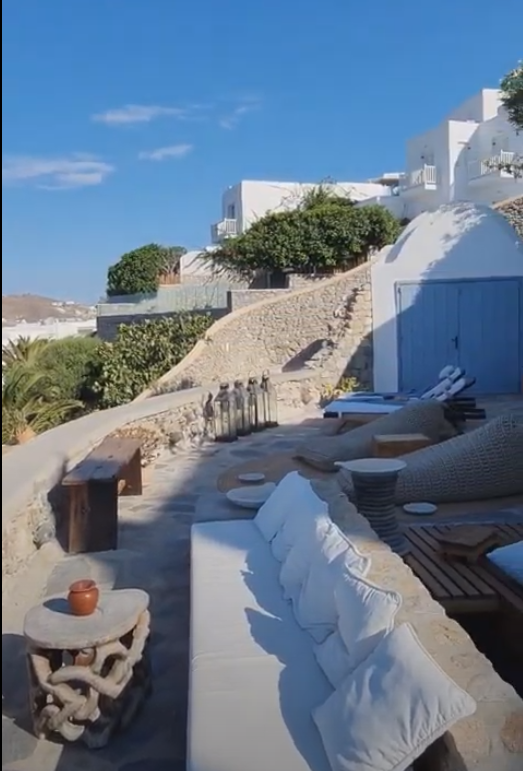Wellness by Design: Part 2
When Maeve asked me to join her in Mykonos a few months ago, I had no idea that I was going to learn so much about wellness architecture! Be sure to read Part 1 to hear how this started and for tips for choosing your next holiday to get the most relaxing or thrilling experience!
In Part 2, we’ll be talking more about how to bring this knowledge into the home.
The third and final Part will delve into lighting and how to determine what a room will be used for!
Colour. Texture. Material.
The three key components of a space that effect how we feel.
Repetition along with limited variety & natural materials equals calming and relaxing environment.
Maeve recently bought a new house that is currently going through a complete renovation. As an architect, she is always working in the best interest of her clients, and for her own home, you best believe she is working in the best interest of herself.
During the planning stages, she took each of these three components into consideration. Repetition of colours, limited number of textures, and natural material.
You wouldn’t necessarily spend a relaxing weekend away exploring times square for the same reason you wouldn’t want to relax in a living room with loads of colours, flashy lights, and shiny plastic (we talk more about Times Square here).
“I don’t want anything plastic in my house because I feel better being surrounded by more natural materials. So many of us use laminate! Laminate floors or furniture. They aren’t biodegradable and they can’t be broken down, refinished, or reused. If we just take mother nature as a guide, she’s telling us to use natural material”
If we think about what we want in our homes, it’s typically not hard shiny surfaces (but if that does sound like you, that’s totally cool!). We tend to be drawn towards timber, stone, silk, linen.
The reason these fabrics are more appealing is they are physically more pleasant; they are breathable and allow our body to regulate temperature. Think about going out for dinner and drinks and sitting on a polyester sofa or pleather seat in a restaurant. Chances are you’d you get a sweaty ass.
But really, it goes so much deeper than physical comfort.
On an innate level, we feel that natural materials are a part of the same natural world as us. It’s grounding, as if we are bringing the forest into the home.
So natural materials are physically pleasant & grounding - what else?
Well! There are also acoustic benefits to having natural materials, especially those with certain textures.
Not only do textures make you feel better in many aspects, but they also affect what you can hear and the quality of sound.
When you’re having a deep conversation at a nice restaurant, you can’t hear the people in the booths next to you because of the way the acoustics work due to the paneled plasterwork in the ceiling, timber paneling in the walls, upholstered seating, and ornate frames around photographs.
Think about it for a second. If you were at a nicer restaurant, you’d likely see plush booths, paneled walls, and decent timber floor. On the other hand, if you’re at a cheap restaurant, you’d probably see smooth floors and tables, flat walls, and florescent lighting (we’ll talk more about lighting in Part 3!). Not only would they have different feels physically, but you would also have a completely different sound-based experience.
We experienced a perfect example of how to use colour, texture & material to create a pleasant and relaxing environment in Mykonos.
The guesthouse we were staying at was beyond incredible.
Everything was made of natural materials, and there was a limited palette of neutral colours.
We were comfortable laying on the sunbeds and bean bags, even as the day became hot and we became sweaty, since the material wasn’t pooling the seat under us or sticking to our skin.
The kitchen table was backed by wall of exposed stone and the pillows on the bench went right along with the theme of neutral colour, natural material, and limited texture.
What does this mean for you?
If you are renovating your home or redesigning a space, here are some practical things to consider:
Consider your goals or intent for the space?
Do you want a living room you can relax in?
Do you want a game room you can entertain in?
Invest in natural materials for furniture
They will last longer and wear better and many can be completely cleaned and disinfected.
Try to keep your colour palette limited
Three colours + all the plants you want
Limit the number of textures you have
Use nature as a guide: think of a smooth beetle shell, a furry dog, glassy water
Timber table, floor, and plaster walls can be smooth
Furniture needs to be upholstery that’s comfortable
Really textured things like rugs, cushions, throws can add in another dimension
Make sure you are getting sunlight in rooms you will be in (more on this in Part 3!)
This doesn’t have to break the bank, either!
Maeve is the perfect example of how to plan & shop (properly). Her and her husband had their eye on a table for their new house, so rather than spend the €1200 it was listed for, they snatched it for €220 locally. It wasn’t the colour they wanted, but it can be sanded down and stained to be right colour for a lot cheaper - which means more money for other parts of the house.
You have a table, now what about the chairs?
Instead of purchasing expensive chairs, Maeve and her husband are using linen chair covers and re-using the old chairs from Maeve’s mum’s house. Before she thought of using chair covers, they considered sanding and re-covering the old chairs with leather, because they had decided early on that chairs weren’t something they wanted to spend money on.
Colour. Texture. Material. Simple & effective.
Be sure to read Part 3 to see how to start thinking about lighting and the effects it has on our environment & mood!
Maeve Staunton Henderson is director of architectural practice of the same name, Staunton Henderson. She is qualified from the prominent architecture school in London, the Architectural Association. Previous alumni include Sir. Richard Rogers, Sir. Norman Foster, Dame Zaha Hadid.
The practice is a two time AIBF Business All Star winner for trust, performance & customer-centricity. Maeve is an RIAI member.
Maeve was raised in Longford, studied in Dublin & London. She has worked in London, New York and in Cambodia for a Yale research project. She is currently building her dream home in Sligo for her family.
You can learn more about Maeve and her work by visiting her website or following her on instagram

